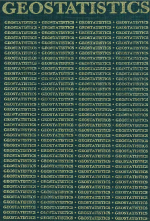Добрый день, Коллеги. Важное сообщение, просьба принять участие. Музей Ферсмана ищет помощь для реставрационных работ в помещении. Подробности по ссылке
Geostatistics / Геостатистика
Miners and geologists have always known that the value of minerals in a given volume of ore depends heavily on the position of the ore in the orebody and on the value of the ground surrounding it. Thus, traditional methods of ore reserve estimation have attempted to combine data, on the position of the sample with an intuitive notion of "area of influence" to produce usable results. Polygonal and triangular weighting, rectangular zones of influence, and inverse distance methods were all developed so that both characteristics—spatial position and value of surrounding ground-would be included in the estimation. However, there is no objective way to measure the reliability of these estimating techniques.
In an attempt to produce estimators for which confidence limits might be derived, workers in the field have borrowed or developed techniques based on formal statistical theory. Unfortunately, these techniques were originally developed for random observations of independent individuals in a given population, with no regard for spatial position.
Therefore, both approaches have to some extent fallen short. The classical approach embodies the notion of the spatial variation of values at the expense of quantitative measures of reliability. The formal statistical methods produce confidence limits but ignore spatial relationships within the deposit.
Following earlier empirical work by Krige, Matheron developed the theory of regionalized variables specifically to resolve these problems.
A random variable is a measurement of individuals that is expected to vary between individuals in some probabilistic way. A regionalized variable is a random variable that takes different values according to its position within some region. In ore reserve estimation, the orebody is the region, and grade, thickness of ore, density, or any other desired measure are the regionalized variables. The behavior of ore grades within any given deposit conditions this method of reserve estimation to that particular deposit <...>




